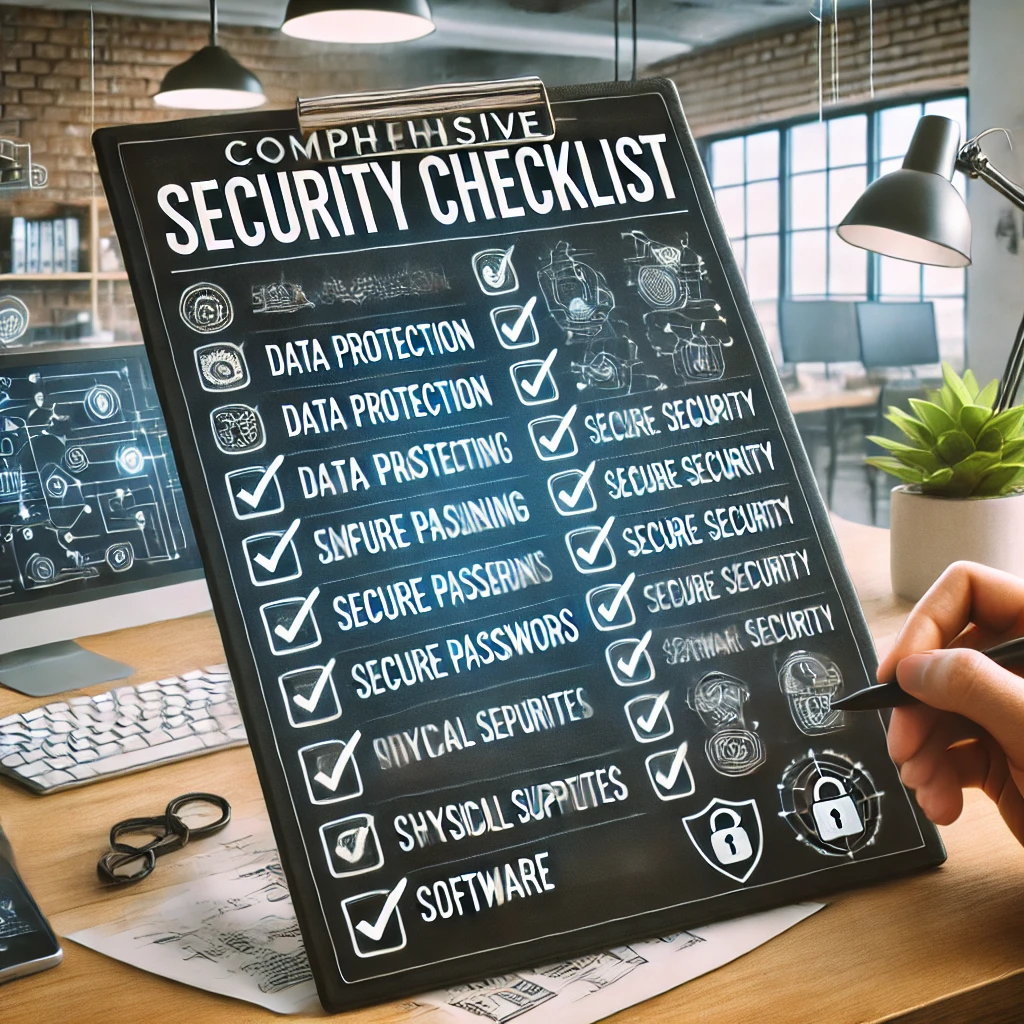A comprehensive security checklist for small business owners is essential for protecting sensitive data, ensuring operational continuity, and building trust with customers. Here’s a detailed checklist broken down into key areas to help you secure your business:
- Network Security
- Firewall Configuration: Install and configure a firewall (hardware and software) to block unauthorized access.
- Router Security: Change default credentials and use strong passwords. Disable remote access unless necessary.
- Wi-Fi Security: Enable WPA3 encryption (or at least WPA2). Hide SSID, use a strong password, and create a guest network for visitors.
- VPN for Remote Access: Implement a VPN to secure remote access to the network, especially for employees working from home.
- Network Segmentation: Separate internal business-critical systems from public-facing or less critical systems.
- Access Control
- Strong Passwords: Enforce strong password policies (e.g., 12+ characters, mixed-case letters, numbers, symbols).
- Multi-Factor Authentication (MFA): Use MFA wherever possible, especially for email, VPNs, and sensitive business applications.
- Principle of Least Privilege (PoLP): Grant employees access only to the data and systems they need to do their job.
- Role-Based Access Control (RBAC): Define roles and grant permissions based on job responsibilities.
- Regular Auditing: Perform routine reviews of user access rights and permissions. Remove unnecessary accounts or privileges.
- Endpoint and Device Security
- Antivirus and Anti-Malware: Install and regularly update antivirus software on all computers and devices.
- Operating System and Software Updates: Enable automatic updates for operating systems and applications to patch vulnerabilities.
- Device Encryption: Use full-disk encryption on all company laptops, desktops, and mobile devices to protect sensitive data.
- Mobile Device Management (MDM): For businesses that use smartphones or tablets, deploy MDM to enforce security policies on mobile devices.
- Secure Backups: Ensure all critical data is backed up regularly, using both local and cloud-based solutions. Test backups periodically.
- Email Security
- Spam Filtering: Use email filtering services to block malicious emails (phishing, malware attachments).
- Email Encryption: Encrypt sensitive email communications, especially those containing financial or personal data.
- Phishing Awareness: Train employees to recognize phishing attempts and report suspicious emails.
- Application and Software Security
- Web Application Firewall (WAF): Protect your website and web apps with a WAF to block malicious traffic.
- Patch Management: Regularly apply patches to applications (e.g., CRM, HR, or accounting software) to close vulnerabilities.
- Secure Development Practices: If developing custom apps, follow secure coding practices and conduct security testing.
- Third-Party Apps: Ensure third-party software vendors adhere to security best practices and sign contracts that include security clauses.
- Data Protection and Privacy
- Data Encryption: Encrypt sensitive data at rest and in transit. Ensure proper encryption standards (AES-256) are used.
- Data Retention Policy: Implement policies for how long to retain data and ensure secure deletion of outdated or unnecessary information.
- Data Classification: Classify business data by sensitivity and apply security controls accordingly (e.g., public, internal, confidential).
- GDPR/CCPA Compliance: If handling customer data, ensure compliance with relevant privacy laws such as GDPR or CCPA.
- Employee Training and Awareness
- Security Awareness Training: Conduct regular training on phishing, social engineering, and safe online practices.
- Incident Reporting: Make sure employees know how to report potential security incidents (e.g., suspicious emails, malware infections).
- Strong Password Policy: Educate staff on creating and managing strong passwords, possibly using password managers.
- Incident Response
- Incident Response Plan (IRP): Develop and document a plan for responding to security incidents. This should include steps for containment, eradication, recovery, and communication.
- Data Breach Response: Prepare a breach notification process for customers and regulatory bodies in case of a data breach.
- SIEM Solution: If possible, invest in a Security Information and Event Management (SIEM) tool to monitor and respond to suspicious activity.
- Physical Security
- Restrict Physical Access: Ensure critical equipment (servers, network gear) is housed in secure locations. Use keycards, locks, or biometric access for restricted areas.
- CCTV Monitoring: Install cameras in sensitive areas and review footage periodically.
- Visitor Log: Maintain a log of visitors and limit access to secure areas for non-employees.
- Business Continuity and Disaster Recovery
- Disaster Recovery Plan: Develop a plan for restoring IT systems after a disaster (e.g., fire, flood, ransomware attack).
- Offsite Backup Storage: Store backups in an offsite or cloud location to ensure availability even if local systems are compromised.
- Redundant Systems: Implement redundancy (e.g., backup power, alternate internet connections) to minimize downtime during an outage.
- Vendor and Partner Management
- Vendor Risk Assessment: Evaluate vendors and partners for their security practices. Ensure they meet your security standards.
- Third-Party Security Audits: Request security reports, audits, or certifications (e.g., SOC 2, ISO 27001) from vendors that handle sensitive data.
- Contract Clauses: Include data protection and breach notification clauses in vendor contracts.
- Compliance and Legal
- Cyber Insurance: Consider purchasing cyber liability insurance to protect against financial losses from cyberattacks.
- Compliance Audits: Conduct regular audits to ensure compliance with industry regulations (e.g., HIPAA for healthcare, PCI-DSS for handling credit card payments).
- Legal Counsel: Engage legal counsel specializing in cybersecurity and data privacy to review your practices and contracts.
- Monitoring and Logging
- Activity Logging: Ensure logging of key activities, such as user logins, access to sensitive files, and network traffic.
- Intrusion Detection System (IDS): Use IDS/IPS (Intrusion Detection and Prevention Systems) to monitor network traffic for suspicious activity.
- Regular Review of Logs: Periodically review logs for unusual patterns or anomalies that could indicate a security threat.
This checklist covers the most important steps, but security is an ongoing process. Regular reviews, audits, and updates will help keep your business protected as technology evolves. Implementing even the basic measures can significantly reduce the risk of cyber threats to your small business.

